Ever thought of wielding nature’s own arsenal, like a modern-day alchemist, to protect your garden? You can craft DIY organic pest sprays that ditch harsh chemicals for safe, effective solutions. Start with simple ingredients like garlic or neem oil, mixing 2 tablespoons with a gallon of water. Curious how these concoctions work their magic on pesky bugs? Stick around, and let’s explore some easy recipes together.
Contents
Garlic Spray Recipe
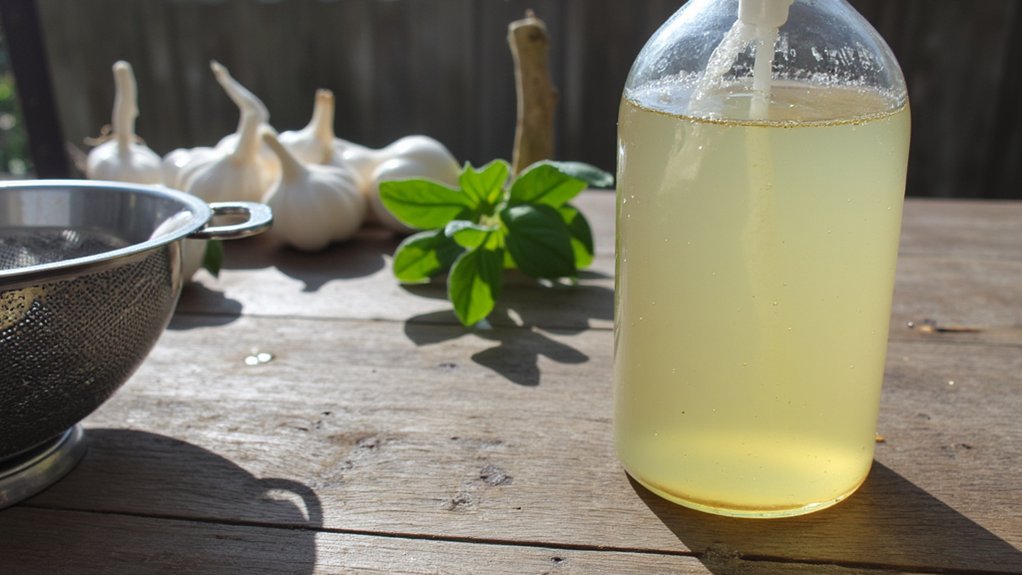
Hey, let’s kick things off with a super simple garlic spray recipe to keep those pesky bugs at bay. You’ve got this, and it’s a breeze to make with stuff you likely have at home. Grab 2 whole garlic bulbs, and let’s get started.
First, peel and crush those garlic bulbs into a fine paste, then mix with 1 quart of water. Let it steep for 24 hours in a covered container, somewhere cool. After that, strain the liquid through a cheesecloth into a spray bottle.
Now, add a teaspoon of dish soap to help it stick to leaves. Shake it up, and spray on your plants early morning or late evening. You’re done—bugs, beware!
Neem Oil Solution
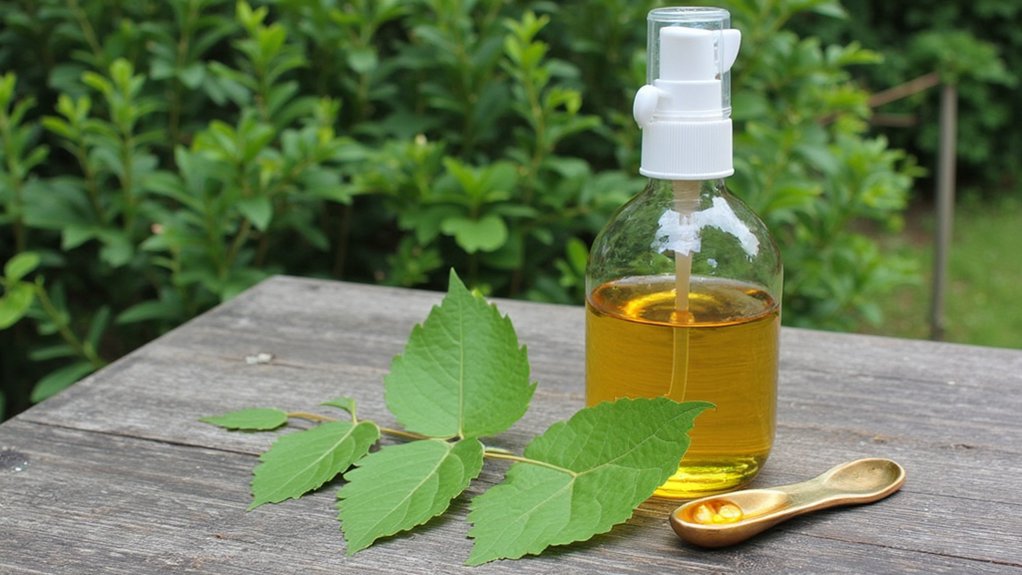
While garlic spray works wonders, let’s explore another powerful option, the neem oil solution, for tackling stubborn pests. You’ve probably got some pesky bugs that just won’t quit, right? Neem oil, derived from the neem tree, messes with their life cycle, stopping them cold.
Here’s how you make it: mix 2 teaspoons of pure neem oil with 1 teaspoon of mild liquid dish soap in a quart of water. Shake it well in a spray bottle to blend everything. Spray this mix on your plants, focusing on the undersides of leaves where pests hide, every 7-14 days.
Keep at it, and you’ll see results. Just remember, apply it in the early morning or late evening to avoid leaf burn from the sun.
Soap-Based Insect Repellent
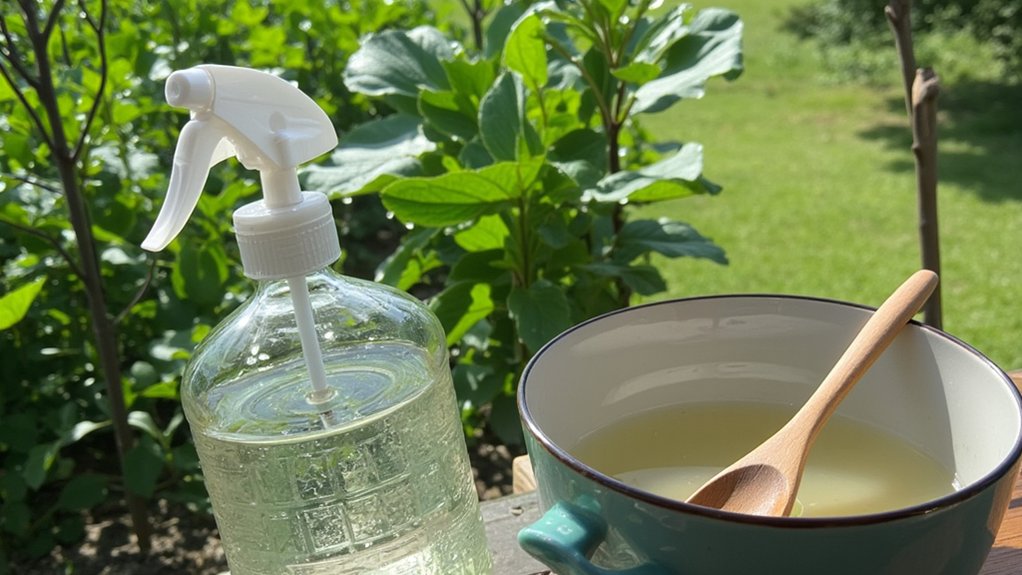
If you’re looking for a simple, effective way to keep bugs at bay, try a soap-based insect repellent. It’s super easy to make, and you’ve likely got the ingredients at home already.
Start by mixing 1 tablespoon of liquid dish soap, ideally unscented, with 1 quart of water. Stir gently in a spray bottle, ensuring it’s well combined, so you don’t create too many suds.
This solution works by breaking down the outer layer of soft-bodied pests like aphids and mites. Spray it directly on affected plants, focusing on the undersides of leaves, early in the morning or late afternoon. Reapply every 5-7 days, or after rain, to keep those pesky bugs under control. You’ve got this!
Chili Pepper Spray
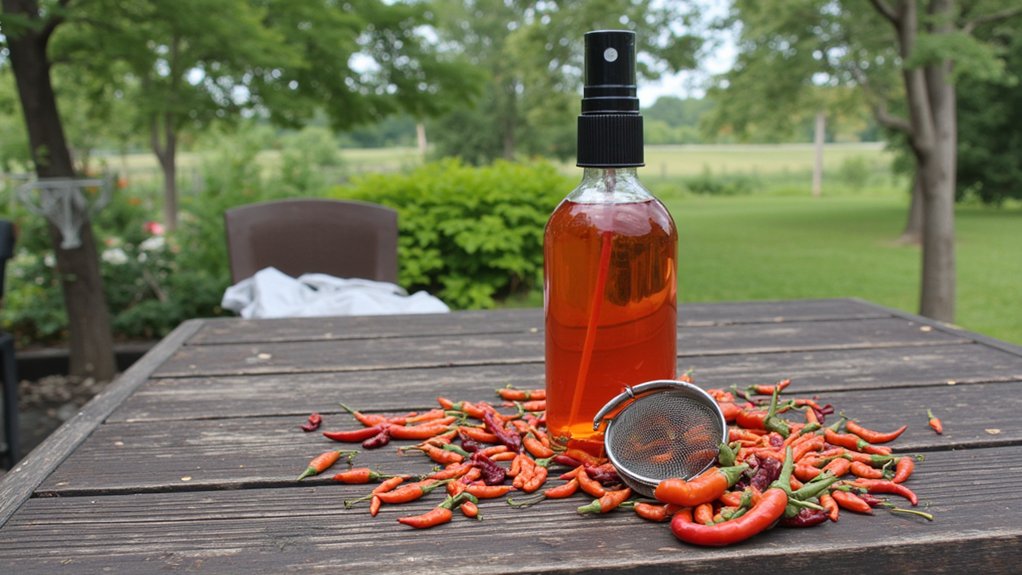
Ready to spice up your pest control game? Let’s whip up a Chili Pepper Spray that’ll send pests packing. This fiery mix uses capsaicin, the heat in peppers, to repel bugs like aphids and caterpillars.
Grab 2 tablespoons of dried chili flakes or 5 fresh hot peppers, and chop them finely if fresh. Boil them in 1 quart of water for 20 minutes, then let it cool completely. Strain the liquid into a spray bottle, add a drop of dish soap for sticking power, and shake well.
Spray this on plant leaves, focusing on infested areas, every 3-5 days. Test a small spot first; some plants might not handle the heat. Reapply after rain, and keep it away from your eyes!
Vinegar Pest Deterrent
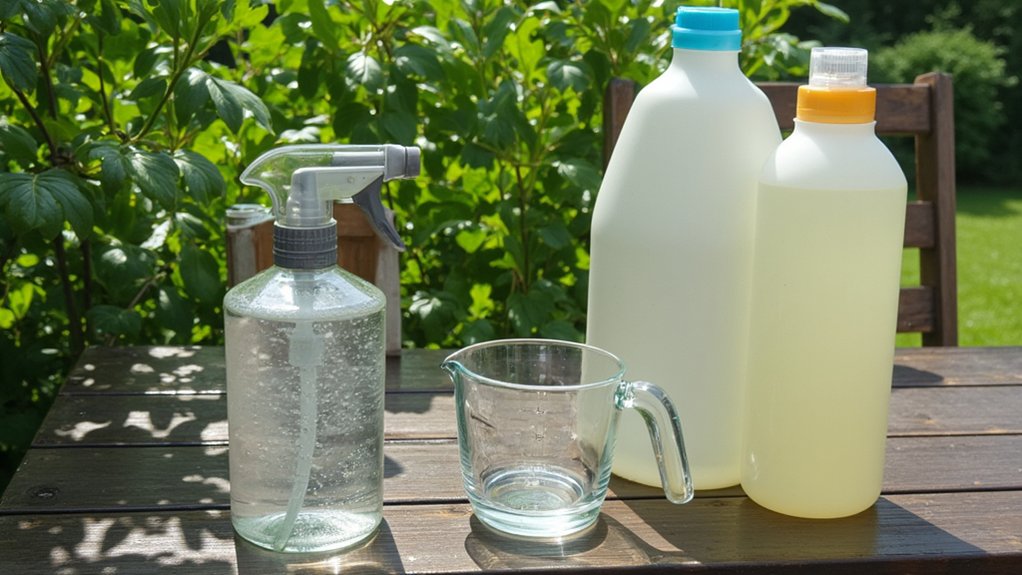
Three simple ingredients can transform your garden into a pest-free zone with a Vinegar Pest Deterrent. You’ve got this, so let’s jump in! Grab white vinegar, water, and a bit of dish soap. This combo repels pests like aphids and ants without harsh chemicals.
Mix one cup of vinegar with three cups of water in a spray bottle. Add just a teaspoon of dish soap, shake it well, and you’re set. Spray this directly on plant leaves, focusing on areas with visible pests. Do this early in the morning, every few days, to keep bugs at bay.
Test a small spot first, though, since some plants might react. Reapply after rain, and watch your garden thrive, bug-free!
Essential Oil Blend
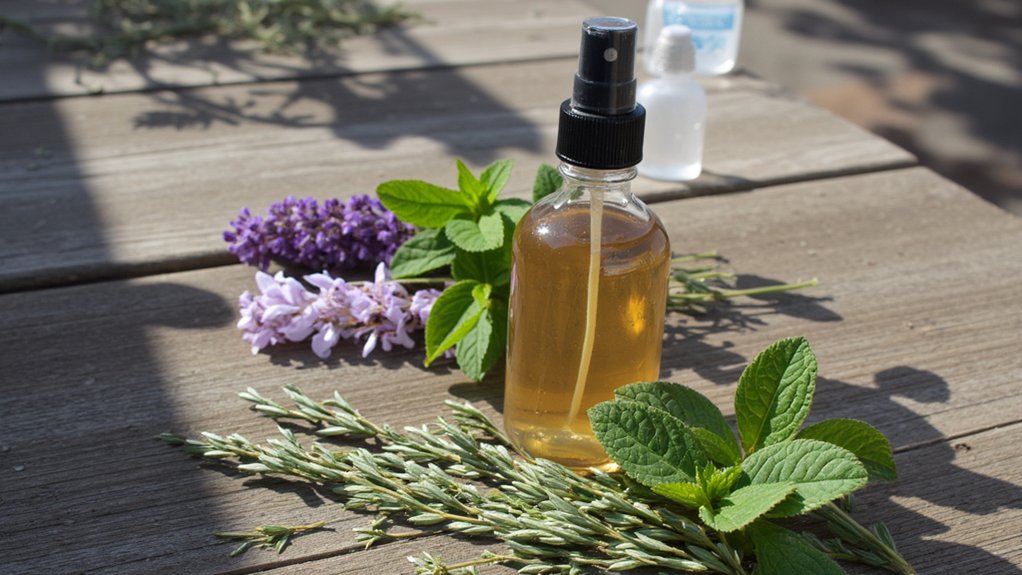
While vinegar works wonders, let’s explore another powerful option with an Essential Oil Blend for pest control. You’ve got nature’s arsenal right at your fingertips, so let’s mix it up!
Start with a clean spray bottle, adding 10 ounces of water. Then, drop in 10 drops each of peppermint, lavender, and eucalyptus essential oils—bugs hate these scents. Shake it well to blend everything evenly, and you’re set. Spray this mix on plant leaves every 3-4 days, especially after rain.
Focus on areas where pests linger, like under leaves or near stems. Don’t drench the plants, though; a light mist works fine. Reapply in the early morning for best results, ensuring the oils don’t evaporate too quickly in heat. Keep at it!
Turmeric Pest Repellent
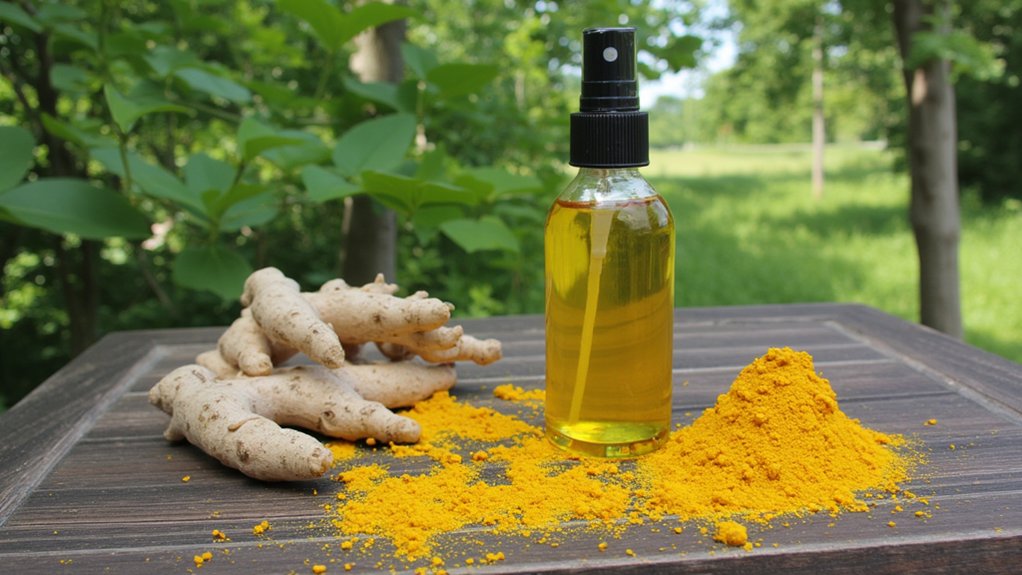
As we explore another natural solution, let’s harness the power of turmeric for pest control. You’ve got a potent ally in this vibrant spice, known for repelling insects like ants and aphids. It’s simple to use, and I’ll walk you through it.
Start by mixing 1 tablespoon of turmeric powder with 1 quart of water in a spray bottle. Shake it well, ensuring the powder disperses evenly, which might take a minute. This creates a strong, natural barrier when applied.
Spray this mixture directly on plant leaves and soil every 3-4 days, especially after rain. Focus on areas where pests gather, like under leaves. You’ll notice fewer critters nibbling your greens. Keep at it, and your garden stays safe, naturally.
Cinnamon Bark Spray
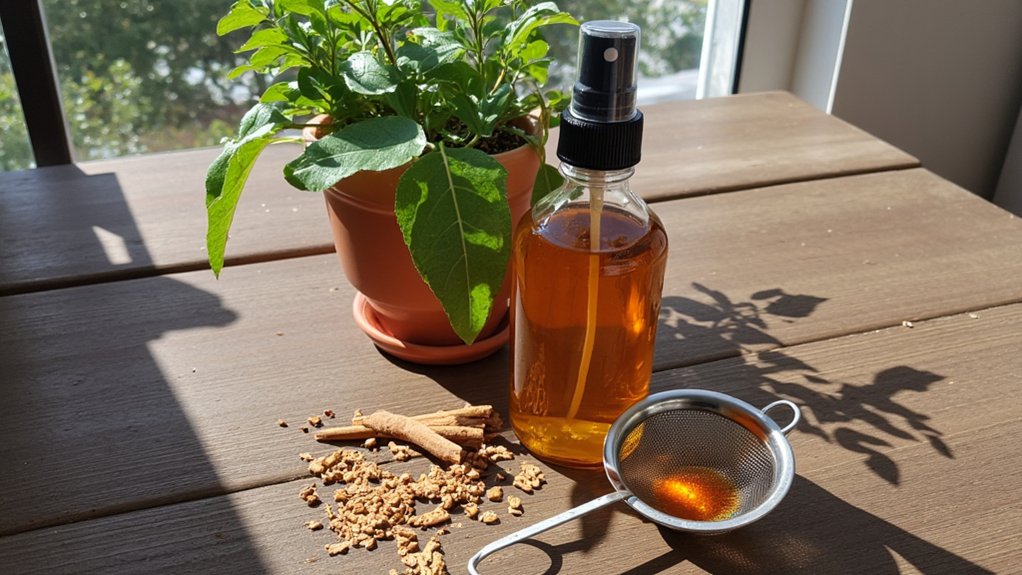
Let’s move on to another powerful natural remedy with cinnamon bark spray, a fantastic option for pest control. You’ve probably got cinnamon in your kitchen, but did you know it repels ants, aphids, and even fungal pests?
Here’s how you make it. Boil 1 tablespoon of cinnamon bark—or 2 teaspoons of ground cinnamon—in 4 cups of water for 10 minutes. Let it cool, strain the liquid into a spray bottle, and add a drop of dish soap to help it stick.
Spray this mix directly on affected plants, focusing on leaves and soil, every 3-4 days. It’s safe, smells kinda nice, and works wonders. Just reapply after rain, as it can wash off pretty easily.
Basil Leaf Infusion

Dive right into another awesome natural pest remedy with a basil leaf infusion, a surprisingly effective tool for your garden. You’ve likely got basil growing already, so let’s use it to repel pesky insects. It’s simple and works great against aphids and mites.
Grab about 2 cups of fresh basil leaves, roughly chopped, and toss them into a pot. Add 4 cups of water, bring it to a boil, then simmer for 10 minutes. After cooling, strain the liquid into a spray bottle, and you’re set to go.
Apply this infusion directly to plant leaves every 3-4 days, especially under leaves where bugs hide. Make sure you cover all areas, and reapply after rain. It’s a quick fix that’s safe for your garden!
Lemon Peel Extract
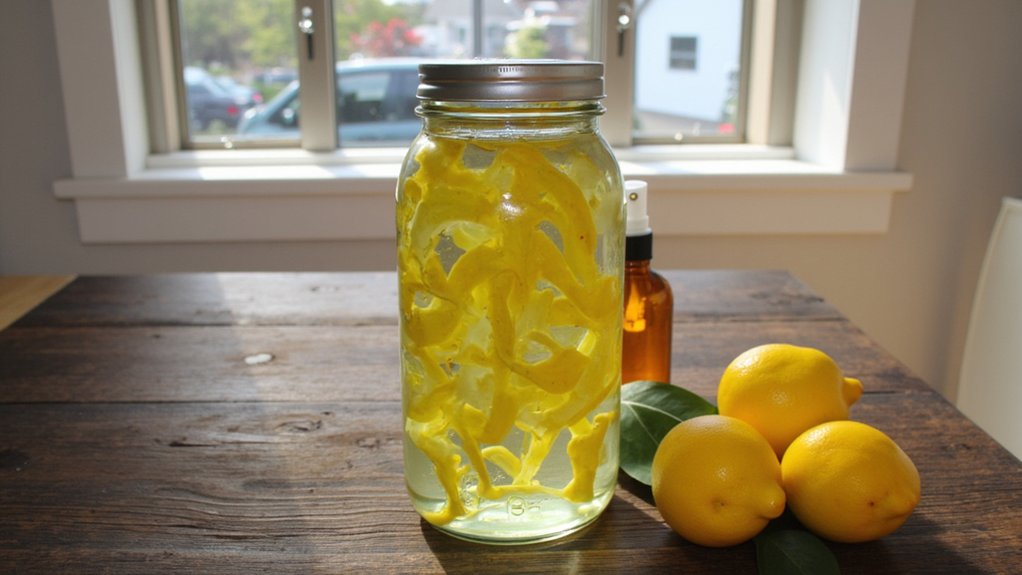
Citrus power is your next weapon against garden pests with this lemon peel extract. You’ve got a simple, effective solution right in your kitchen. Lemons aren’t just for lemonade; their peels pack a punch against bugs.
Start by collecting peels from 2-3 large lemons, ensuring they’re clean and pesticide-free. Place them in a jar, cover with 2 cups of boiling water, and seal it tight. Let it steep for 24 hours in a cool, dark spot, then strain the liquid into a spray bottle.
Apply this directly to infested plants, focusing on leaves and stems, early in the morning. Reapply every 3-4 days, or after rain, to keep pests like aphids and ants at bay. It’s that easy!
